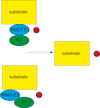Ubiquitin ligases and beyond
- PMID: 22420755
- PMCID: PMC3305657
- DOI: 10.1186/1741-7007-10-22
Ubiquitin ligases and beyond
Figures



Comment on
-
Cnidocyte discharge is regulated by light and opsin-mediated phototransduction.BMC Biol. 2012 Mar 5;10:17. doi: 10.1186/1741-7007-10-17. BMC Biol. 2012. PMID: 22390726 Free PMC article.
References
Publication types
MeSH terms
Substances
LinkOut - more resources
Full Text Sources

